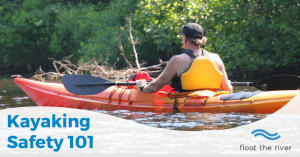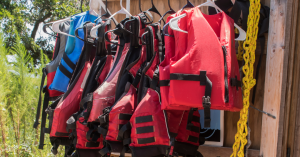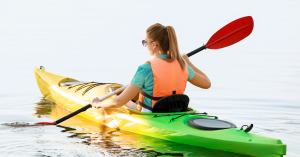Stay Safe and Enjoy the Waters: Essential Kayaking Rules to Know

If you are considering learning the fun sport of kayaking to stay fit or simply enjoy some time on the water with family and friends, then learning kayak safety is paramount. Nothing is more important when embarking on this journey than knowing how to keep yourself safe. Read on for more information on the essential rules for kayakers.
Table of Contents
- Is The Sport of Kayaking Safe Overall?
- What Are the Golden Rules to Remember About Kayaking Safety?
- What should you do if the kayak flips?
- What are the safest methods to use when exiting or entering a kayak?
- What Is a Float Plan, and Should You Create One?
- What Does “Paddle Responsibly” Mean?
- What Safety Equipment Should You Always Have Within Your Kayak Gear?
- Common Mistakes to Avoid When Kayaking
- Should You Kayak on Your Own or Use a Company’s Help?
Is the Sport of Kayaking Safe Overall?
Generally, kayaking is a safe way to spend your time. It is also low impact, making it a great way to stay fit. However, because it takes place on water and dangers are associated with being on or near any body of water, the sport isn’t without some risks, though they are minimal. Thankfully, you will reduce these risks immensely by learning the sport’s essential rules and safety standards.
What Are the Golden Rules to Remember About Kayaking Safety?
When safely mastering the sport of kayaking, remember the three main golden rules. Adhering to these will go a long way toward keeping you safe on the water:
Wear a PFD: “PFD” stands for “personal flotation device,” which can include a buoyancy aid, life belt, life preserver, or some sort of life vest or jacket. Wearing or having a PFD on your vessel or person is a legal requirement within the United States in most bodies of water, so this is one of the must-follow golden rules of kayaking.

Learn to Swim: If you don’t know how then learning to swim before you attempt the sport of kayaking is imperative. You don’t have to be a super-strong swimmer; just be able to tread water using basic strokes. Basic swimming is more than adequate when kayaking in calmer waters, like calm rivers or shallow waterways. If you are kayaking in open water, such as sea kayaking, you must be a much stronger swimmer.
Know Basic Information: You need to learn essential information about any location you plan to kayak, including any potential hazards along the river and weather forecasts for the area. These are vital to keeping you safe when embarking on your kayak adventure. Remember that it’s not just rain or thunderstorms that can play a role in your safety on the water, though they can; it’s also wind and water temperature. It’s helpful to keep in mind the 120-degree rule, which states that you should wear a dry suit or wetsuit when the total water temperature and air temperature are equal to or less than 120 degrees Fahrenheit.
What should you do if your kayak flips?
Although the possibility of a kayak capsize is scary, especially on your first-ever trip, it’s essential to prepare for this ahead of time. In other words, practice what to do if you capsize in calm waters when you have help nearby. Then, when it happens in another setting, you are prepared and have muscle memory of what to do to get out of the situation. When you capsize, the main thing to remember is to stay calm, exit your kayak, and then get back into your kayak once in a safe area.
What are the safest methods to use when exiting or entering a kayak?
Getting in and out of your kayak is typically one of the scariest aspects of kayaking overall. Thankfully, it doesn’t have to be as intimidating as it seems. It just takes practice, like anything else. Here are some of the easiest methods:
- Straddle Method: This means you straddle your kayak in shallow water. To get in this position, squat down, hold the rim, and lower your rear end into the seat. Then, lift one leg at a time out of the water, sliding it into the kayak. When you are situated, push off from the shore with your paddle.
- Paddle-Bridge Method: Place your paddle right behind the rim of the cockpit. Squat down or step in front of the paddle, placing one hand on the cockpit and one on the paddle. Tilt the kayak, grounding the paddle blade. While keeping pressure on the paddle blade, put one leg and the other into the cockpit.
- Ground It: When getting out of the kayak, unless you want to practice your capsize technique and self-rescue while getting wet, the easiest method is likely to be by grounding it. Do this by paddling to the side of the river and grounding the front of your kayak in the gravel or sand. The ground will help hold the kayak still as you exit.
What Is a Float Plan, and Should You Create One?
A float plan is very similar to a flight plan for a plane. It gives others critical information about your kayaking plan, including when you plan on leaving, when you aim to arrive or conclude your trip, and information about your boat, etc.
Having a float plan as a kayaker isn’t required, but it is a good idea. Sharing critical information, such as who is with you in your group and the contact information of everyone involved, can save lives.

What Does “Paddle Responsibly” Mean?
It means using your paddles properly and maintaining distance from obstacles and other kayakers. You want to keep your own area and not enter another person’s space, potentially causing an accident.
What Safety Equipment Should You Always Have Within Your Kayak Gear?
The safety equipment you take with you should include, first and foremost, your PFD, along with a whistle or other type of signal device to indicate you need help, a sponge or bilge pump to remove water (in case of capsize), and a cellphone or other type of communication device, which should be placed in a waterproof bag. You should also consider the following elements to improve your overall safety:
- Dressing for immersion: You typically want to avoid being immersed in kayaking. However, you should always dress for the chance that you could end up in the water. Cold water and hypothermia are two of the most significant risks for kayakers, so ensure you are prepared for anything when water temperatures are low.
- Staying hydrated is critical for kayaking: Paddling a kayak takes physical exertion, so bring along water or other forms of hydration to ensure you don’t get dehydrated.
- Knowing that first aid can be a lifesaver: A small cut or scrape, an intense headache, or other minor medical issue can cause problems when on the river, so having a first aid kit can help immensely.
Common Mistakes to Avoid When Kayaking
Nearly 10 million kayakers regularly enjoy the sport throughout the country. Of those, only a few get hurt, and even fewer experience fatal accidents. However, the primary way to avoid any accident on the river is to avoid common mistakes and to put the kayaking safety tips listed previously into practice, as many times, pre-planning and common sense are all necessary to prevent problems.
- Launching in dangerous waters: Never attempt to paddle rough waves or rocky entries when learning to kayak.
- Attempting to navigate overly crowded areas: Again, when learning, ease into the sport; don’t go out and try to fight against swimmers, canoes, other boats, and more. Stick with an area where you can have space to learn and perfect your skills.
- Not checking the weather: Although it has already been mentioned once, it’s necessary enough to restate. Don’t try to kayak when the weather is overly cold, stormy, rainy, windy, or even excessively hot.
- Being overconfident: Remember, you are learning the skill of kayaking. So, don’t get overconfident and try to attempt too much too soon. Stay within what you know and gradually learn how to do more and more.
Should You Kayak on Your Own or Use a Company’s Help?
Choosing Float the River for your kayaking adventure on the Cuyahoga River and Cuyahoga Falls promises an unparalleled experience for all levels of enthusiasts. If you’re a beginner, our Cuyahoga Falls Kayak Rental offers the perfect opportunity to test the waters, with short, manageable trips of 45 minutes to an hour and no swift-moving water to worry about.
Our offerings extend from solo to tandem kayaks, ensuring a customized experience, whether you’d prefer a solitary sojourn or sharing the experience with a loved one. For a worry-free journey, Float the River has your back. Book your next kayaking trip with us today!
